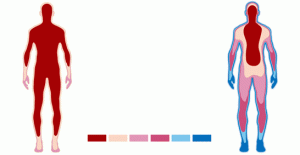Chapter 5: The Afterdrop – What it is and How to Manage it
After your body finally gets acclimated to the colder water, you’ll be surprised at how easily you can complete a 30-minute swim. However, as we have discovered on multiple occasions, your biggest challenge will not be during the swim itself.
As strange as this seems, you will be much more at risk for developing hypothermia during the 10-20 minute period AFTER you get out of the water. This is due to a physiological phenomenon known as the “afterdrop.”
So let’s take a look at what actually happens leading up to and during the afterdrop.
When you first enter the water and begin your swim, your body reacts by constricting the peripheral blood vessels in your arms and legs. This helps prevent heat loss by consolidating your body heat into your core. And as long as you continue with your physical activity, you will easily preserve a stable temperature.
However, once you end your swim and exit the water, your body sends your blood back to the skin to “warm up.” Because your skin is very cold at this point, your blood actually gets colder and is then recirculated back to your core. In essence, your core body temperature actually decreases during this rewarming period in a phenomenon known as the “afterdrop.”
There are two keys to managing the afterdrop:
1) When you end your swim workout, get out of the water right away. Don’t dally around and expose your skin to the cold water while your heart rate begins to drop.
2) Rewarm your core as well as your periphery. This means placing warm, dry layers onto your torso and head and getting some hot liquid into your stomach to warm up your core from the inside. You may have cold hands and feet, but these are secondary concerns.
After I get out of the water, my modus operandi is to get out of the wet neoprene as quickly as possible. I’ll start with my hood and gloves, and I’ll immediately place a warm cap on after I dry off my head. I’ll then remove the top part of my wetsuit and throw on a warm, long sleeve shirt or sweatshirt (or two).
Next come the booties and the rest of the wetsuit. After a quick dry off, I’ll swap out my inner swim gear for some warm sweat pants and then start layering onto my torso. By the time I’m finished, I’ll have 2-3 layers underneath my winter parka along with a thick cap and winter gloves. Plus, I’ll already be drinking the first of many cups of hot tea from my thermos.
But even with all these post-swim preparations, you can still get a pretty mean afterdrop! I’ve had ones so intense that my jaw has locked up and I couldn’t hold a full cup of tea without spilling it all over the place due to the shivering! But, fortunately, if you do all the preparation on the front end, you can keep these experiences to a minimum as well.

